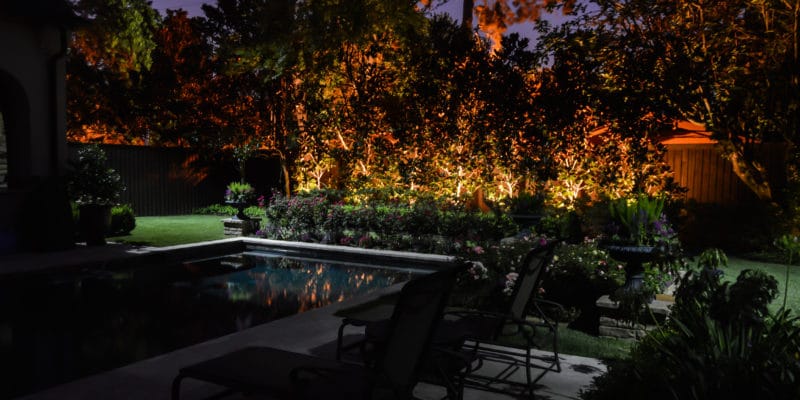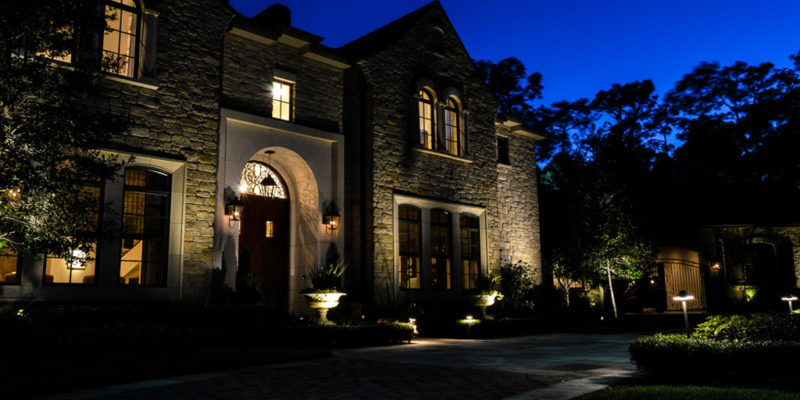Some Of Robert’s Houston Outdoor Lighting Tips
Indoor
Hall & Foyer
Welcome your guests and make a grand first impression with a well-lit entry foyer or hall. Choose a correctly sized lighting fixture for the area while keeping in mind that the bottom of the fixture should be at least 7 ft. from the floor. this will also help you determine whether you want to use a chandelier, flush-mount, or pendant.
When sizing a pendant or chandelier for your foyer, be sure to ass the width and length dimensions together and convert them into inches. For example, a 10 ft. by 10 ft. area would be best illuminated by a 20-inch-diameter fixture (10 plus 10 equals 20). You can use this formula in other rooms where you plan on hanging chandeliers.
If it’s a 2-story foyer featuring a large window above the front door, then it’s best to place the chandelier at the center so that it can be seen from the outside. For foyers that are extra-large, scones are more recommended and these should be installed at about eye-level, ideally 66 inches from the floor.
Dining Room
The place where you serve dinner should be as tasteful as your meals. Create a grand atmosphere by layering the light with wall scones and a chandelier placed in a way that enhances the architectural details like a built-in archway or china cabinet.
With the formula described above, calculate the size of your chandelier or the diameter of the chandelier at three quarters the width of the dining table. Ideally, the bottom of the chandelier should be about 30 In. To 32 In. above the top of the table.
Kitchen
Create a functional and comfortable space in your kitchen by combining lighting. Consider having a flush mount ceiling fixture complemented by undercabinet pendants and/or fixtures. Keep in mind that the pendants need to be placed such that the bottom of each fixture is 28 inches to 34 inches from the work surface.
Bathroom: Single-light scones can be used in small powder rooms to illuminate the room. For larger bathrooms, you can include a number of different kinds of lighting fixtures. Consider mounting a bath fixture directly above the vanity mirror to achieve horizontal illumination. They should also be installed about 75 inches to 80 inches above the floor. For double vanity setups, each sink needs to have its own source of light.
Outdoor
Curb Appeal
This is the first impression that other people will have of your home as seen from the street. As such, you need to make the most of it, whether you’re a homeowner welcoming family and friends, or a builder looking to market a home for a sale.
The exterior light fixtures are some of the first things that other people notice at the first impression. Aptly styled and sized fixtures will add on to the curb appeal, safely guide the visitors to your door, and provide a warm welcome. The key factors to consider when choosing them to include color, size, and style.
Size
One of the biggest mistakes people make when choosing their outdoor lighting is going for fixtures that are too small. If you are replacing already existing fixtures, don’t assume that the original ones were the right size, to begin with – some builders tend to use small fixtures to save costs.
Lighting fixtures will only look about half as big on your house when they’re viewed by the street as they do in the showroom. So, when choosing between two sizes, the larger one is almost always the better choice.
The front door it a very important area. As such, it should have the biggest and the fanciest light fixture on your house. Don’t let the secondary fixtures at secondary entrances, such as the garage fixtures, upstage the fixtures around your front door.
A good rule of thumb is to make sure the fixture on the front door is 1/3 of the height of a single door, and 1/4 the height of a double door – one on each side. You can cut a piece of cardboard to shape and then hold it up to your house to help you visualize the size better.
Color
It’s important to choose a color that complements the color scheme of your outdoor décor. Bronzes are quite popular with earth tones. We do offer a number of different variations of bronzes from light to dark, including black coral, architectural bronze, bronze, black gold, marbleized mahogany, and burled walnut.
Black is apt for many situations, though bronze is usually preferred when using dark brown trims and accents. Our stone finish is featured in the black family, though it has a hint of grey rubbed on top, which makes it ideal when the bronzes are inappropriate and pure black is too strong. White can be rather striking on a dark bodied house with white accents or trims.
Style
Many contemporary homes don’t have a particular style, as they incorporate different elements of different styles. When choosing a style for your outdoor light fixtures, be sure to pay attention to the main architectural features of your home and the choose fixtures that will complement these features. Get fixtures for your front door simply because it’s the most important door in your home. You can then choose the rest of your outdoor fixtures from the same family of style to maintain consistency.
What about the light intensity? Go for 60W to 75W per fixture or about 20W for compact fluorescent (CFL), which is usually recommended for decorative post lanterns and exterior wall fixtures. Many fixtures on our portfolio are rates for more than 60W. This rating represents the maximum safe wattage allowed, and not necessarily the wattage that’s most appropriate.
Using bulbs that are brighter than necessary will detract from the fixtures as they increase the total glare. The glare will be much worse when you have fixtures featuring clear glass. Focus more on the size and style of the fixture when making your decision, and only use the wattage you need.
Mounting Height
Wall-mounted outdoor light fixtures should ideally be installed slightly above eye level, for houses roughly 66 inches above the threshold. If your house has a transom or taller than normal doors, you might need to install fixtures that are a little higher than 66 inches. You should not install fixtures such that the top extends above the top of the door.
We provide several kinds of fixtures where the body of the fixture is low in respect to the junction box in order to accommodate situations where the junction box might be too high.
Specific Situations
Front Door
The most popular way of lighting the front door is with a pair of lighting fixtures, one on either side of the door. Having a fixture on only one side of the front door can also be done if the architecture or space dictates. If you’re only using one fixture, ensure that it’s installed on the same side as the doorknob, so that your visitors’ shadows won’t be cast on it when opening the door.
If the front door is under cover such as a porch, you might want to consider hanging a lantern instead. Choose fixtures that are about 1/3 of the height of the door when you opt to use one fixture, and 1/4 the height of the door if you’re using two.
Garage Doors
Use a lantern on either side of the garage door or one lantern on top of each door based on the door style and the available space. Choose fixtures that ideally match the front door but are a bit smaller or lesser important looking. The fixtures you install on your garage shouldn’t upstage those installed on the front door.
Back Doors
Here, don’t skimp. Go for fixtures that complement the décor on the rest of the house, and are not small. Using small, cheap fixtures won’t look good anywhere, and will actually detract from your patio accessories and furniture.
Post Lanterns
Go for post lanterns when the light from the front door isn’t enough to light up the parking area. Choose post lanterns from the same family as the rest of the exterior fixtures, and be sure that they are large enough. Post lanterns will look even smaller than the wall fixtures when they’re viewed from the street.
Patio/Deck Lighting
Post lighting fixtures can be installed all around the perimeter of the patio or deck using pier mounts on the wall or railing, or even standard posts installed from the ground. Certain fixtures with low-watt bulbs (between 25W to 40W) will look great and give out a more comfortable light than a single fixture with a bright bulb.
Bright bulbs placed at the eye-level will by unnecessarily glary, and will generally be offensive to you and your guests around the patio.
Other Considerations
Energy Savings
With most of our fixtures, you can use energy saving bulbs.
Dark Sky
Many states and cities are increasingly passing the “dark sky” ordinances in order to control the amount of light pollution. We provide a large selection of fixtures that direct almost all of their light downwards to adhere to these ordinances and address these needs.
Construction Material
Most of our fixtures are made from cast aluminum, which is quite a durable material for most parts of Northern America. If you’re seeking greater durability and prevention of corrosion and rusting, there are other available alternatives.
For engineering and design reasons, some incidental parts have to be made from certain materials. And since our products are often exposed to harsh weather conditions, we aim to only use materials that provide good value and durability.
Maintenance
Exposure to UV rays from sunshine will wear the exterior lighting fixtures quite fast. Other major culprits include airborne pollution and bird droppings that settles as grime and dust. For best results:
- Wipe down bird droppings and other spills off the fixtures immediately you spot them using plain water on a clean, soft, wet cloth.
- Wipe the fixtures once or twice a year.
- Polish your fixtures using silicone car wax after every cleaning.
All Robert Huff Illuminations outdoor lighting fixtures are either ETL or UL listed for wet and damp locations. A fixture with a wet location listing is required when water and/or other liquids splash, drips, or flow on or against the fixtures. You can always use a wet or damp listing outside.
Call or contact us today if you require any information. Please feel free to visit our blog for more related articles.


